Watts Dormont 2650NPVF36 User manual

Flexible Gas Hose
Installation and
Operating Instructions
To be left with the operator after installation
KM 39643
BS 669-2:1997

2
1. The installation MUST BE in compliance with BS 6173:2001-Installation of gas-fired catering appliances
for use in all types of catering establishments (1st, 2nd and 3rd family gases).
2. Installation and testing MUST BE carried out by a Gas Safe registered installation engineer.
3. Cleaning solutions and chemicals must not come into contact with any part of the gas hose. This
includes acids, solvents, fluxes, chlorinated chemicals etc. In the event of contact with the gas hose,
rinse immediately with clean water and dry thoroughly.
4. Contact with sharp objects, wiring etc. and surfaces at temperatures in excess of 105 degrees celsius
shall be avoided.
5. Bending and flexing of hoses should be limited to movement required to carefully push and pull
appliance into and out of position for cleaning and maintenance.
6. Gas hoses are for use with 1st, 2nd, and 3rd family gas, operating at a pressure not in excess of
50mbar.
7. End fittings are bonded into the ends of the gas hose, and no attempt should be made to remove them.
8. Once fitted, gas hoses must not be reused on another appliance or at another location.
9. THE HOSE ASSEMBLY MUST BE FITTED SO THAT GAS ENTERS THE FEMALE HALF OF THE
QUICK-DISCONNECT COUPLING AND EXITS THE MALE (NIPPLE) HALF. DIRECTION ARROWS ARE
PERMANENTLY MARKED ON THE QUICK-DISCONNECT COUPLING.
10. Never insert screwdrivers, probes etc. into the quick-disconnect coupling. This will damage the valve
assembly.
11. Never allow the gas hose to be kinked, twisted, torqued or pinched when installed.
12. Ensure that only the restraining device supplied with the Dormont hose is fitted. The restraining
device must be used when the appliance is in service, and should be inspected as part of the regular
maintenance and safety procedures.
13. Use only one gas hose per appliance.
14. For installations where greater mobility is required, Dormont Swivel MAX® gas hose assemblies are
recommended.
15. Quick-disconnect coupling must be disconnected prior to maximum movement of appliance to avoid
over extending the gas hose. Whenever the appliance is moved for cleaning or maintenance, the
instructions contained within this booklet must be followed.
Flexible Gas Hose
Installation and
Operating Instructions
WARNING
!
WARNING
!
Read this Manual BEFORE operating this equipment.
Failure to read and follow all safety and use information can result in death,
serious personal injury, property damage, or damage to the equipment.
Keep this Manual for future reference.

3
1. Before commencing with the installation, carefully read all sections of this instruction booklet, including the WARNING
section and the installation correct/incorrect section. Installation work should only be carried out in accordance with
BS 6173 by a Gas Safe registered installation engineer.
2. The accessible manually operated shut-off valve shall be installed in accordance with BS 6173:2001. This gas isola-
tion valve (A) must be in the ‘off’ position. If there is no local gas isolation valve fitted, the main gas isolation valve
must be turned off. Do not commence with installation unless the gas supply is fully isolated.
3. Remove the Dormont gas hose and fittings from the bag/box.
4. The location of the gas connection point on site in relation to the gas connection point on the appliance can vary
greatly. It is not possible to illustrate every possible installation combination, and these instructions illustrate a few
examples. The installation engineer must take great care to ensure that the gas hose is not kinked, twisted or taut
when installed, and that the end fittings of the gas hose are not subjected to sharp bends. The installation shall be
such as to avoid excessive flexing, bending or vibration in service. Please refer to the section of this manual for
correct and incorrect installations. For installation situations where sharp bends are a possibility, or are unavoidable,
Dormont Swivel MAX®fittings are recommended.
5. It is recommended that the connection point for the hose at the installation end is fixed at 600mm – 770mm AFFL and
is facing downward. This is dependent upon the length of hose to be used and the gas connection position on the appli-
ance. The gas outlet, to which the hose is to be connected, shall be located in the same room as the appliance. The gas
hose assembly must not be concealed within, or run through any wall, floor, or partition. The gas hose must not come
into contact with the floor during use.
6. To facilitate moving of the appliance as close to the wall as possible, the
two ends of the gas hose should be offset from each other (refer to figure 2).
7. The quick-disconnect coupling must be fitted so that the gas enters the
female half (valved) of the coupling and exits the male (nipple) half. Follow
the gas flow direction arrows permanently marked on the coupling.
APPLIANCE SIDE:
8. In order to achieve correct curvature of gas hose, it may be necessary to fit a
90 degree elbow to the appliance connection point (E) fig.1.
Apply appropriate thread jointing compound and tighten into position required.
9. End fittings are supplied bonded into the ends of the Dormont gas hose. Apply appropriate thread jointing compound
to the end fitting threads, and wind the end fitting/gas hose (D) assembly into the appliance connection point.(E.)
10. Ensure that the gas supply and all the appliance control knobs are turned off before connecting to the gas supply.
GAS SUPPLY (INSTALLATION) SIDE:
11. Separate the female half of the quick-disconnect coupling (B) from the male (nipple) half (C) that is bonded into the
end of the gas hose.
12. Apply appropriate thread jointing compound, and thread the female half of the quick-disconnect coupling onto the
supply pipe from the gas isolation valve (A.) Tighten into position.
13. Connect the quick-disconnect nipple (C) into the quick-disconnect female (B.)
14. On completion, the final assembly shall be tested for leaks at all joints. Leak test in accordance with accepted
procedures. Leak test solutions can cause corrosion, so thoroughly rinsing with water is required. Caution: A naked
flame shall not be used for this purpose.
15. When installation of the gas hose is complete, carefully push the appliance back into the required operating position.
Check that the hose is not kinked, over bent, caught under the appliance casters, or touching the floor. Ensure that the
appliance controls are in the off position before turning on the gas supply.
Figure 2
Appliance
View from above
Offset
Wall
A. Local gas isolation valve
B. Female half of quick-disconnect coupling
C. Male (nipple) half of quick-disconnect coupling
D. Dormont gas hose
E. Connection point into appliance
F. Appliance
G. Restraining device
Gas Flow Direction
into contact with the floor during use.
A
B
C
G
D
F
E
Side View
Figure 1
Installation Instructions (refer to figure 1. below)
WARNING
!
WARNING
!

4
INCORRECT CORRECT
INCORRECT CORRECT
INCORRECT CORRECT
INCORRECT CORRECT
INCORRECT CORRECT
Q.D. AT APPLIANCE END Q.D. AT SUPPLY END
AVOID SHARP BENDS–THE CORRECT WAY TO INSTALL METAL HOSE FOR VERTICAL TRAVERSE IS
WITH A SINGLE NATURAL LOOP. AVOID SHARP BENDS THAT STRAIN AND TWIST THE METAL HOSE
AVOID TWISTING THE HOSE
DO NOT ALLOW THE HOSE TO DRAG ON THE FLOOR DURING USE
AVOID FATIGUE, MAINTAIN A CONSTANT LOOP/DIAMETER
Installation Correct/Incorrect Examples
INCORRECT
INCORRECT

5
BTU Capacities
Hose I.D. inches
1/2" 66,000 59,000 56,000
3/4" 152,000 142,000 136,000
1" 246,000 236,000 214,000
1 1/4" N/A 455,000 430,000
The BTU capacities given here were determined under the test conditions specified in BS669 part 2 1997.
The BTU capacities given here are for braided and unbraided gas hoses fitted with standard quick-discon-
nect fittings or Safety Quik®. For sizes/lengths other than those given, or for hoses fitted with Swivel MAX®
fittings, or without quick-disconnect couplings, contact Mechline for advice.
Length (mm) 1000 mm 1200 mm 1500 mm
Figure 3
WARNING
!
NOTICE
Flow rating BTU @ 0.55 sp. gr. natural gas, 0.58 mbar pressure drop, 37.96 MJ/m3
NB: 1 Kw = 3,414 BTU
The restraining devices are designed to be shorter
than the length of the gas hose, and can withstand
a minimum tensile load of 500kg. The restraining
device must be fitted to prevent damage to gas
hose assembly, and must not be attached to gas
supply pipes, to the gas hose assembly, or to any
point which is insufficiently anchored.
Refer to Fig. 3.
NB: The following instructions relate to using the
standard restraining kit available with our hoses. If the
optional Masonry Bolt kit is being used, refer to the
installation instructions provided with its packaging.
1. The restraining device must be installed parallel
and in line with the gas hose.
2. Attach the staple bracket (A) securely to the wall,
using the plastic wall plugs supplied, and 2x 32mm
screws supplied, or an appropriate alternative.
3. Locate a sufficiently strong part of the rear of the
appliance frame. Carefully drill 2x 3mm holes to fix
the staple bracket (A) in position.
4. Thread one loop of the restrainer wire (E) through
the staple bracket (A) and securely fix to the
appliance frame, using the 2x 12mm self-tapping
screws supplied.
5. Attach the snap hook (C) to the restrainer wire (E)
and the staple bracket (A) on the wall.
Restraining Device Installation Instructions
The restraining device must always be connected when the appliance is in service. Installation of the
restraining device must be in accordance with BS 6173.
Refer to Figure 3

6
Design-certified for use with Dormont gas hoses only, the Swivel MAX is sup-
plied fitted as part of the Dormont gas hose assembly when ordered with an
“S” suffix. “2 S” suffix denotes double swivel assembly.
Installation of Swivel MAX Dormont gas hose assemblies should be carried
out in the same method as detailed in this booklet.
The Safety Quik is designed as a combined quick-disconnect coupling/shut off valve, and can be used in
place of the female half of the standard quick-disconnect coupling. Installation should be carried out in the
same method as detailed in this booklet.
How to use:
To disconnect
1. Turn the yellow isolation handle to the ‘off’ position -
horizontal to the gas hose.
2. Push the outer safety sleeve up toward the yellow
handle. This will cause the nipple/gas hose assembly
to disconnect.
The nipple/gas hose cannot be disconnected
until the valve is in the ‘off’ position.
To reconnect:
1. Firmly push the quick-disconnect nipple/gas hose
assembly into the Safety Quik body. This will
allow the outer safety sleeve to return to the
original position.
2. Turn the yellow isolation handle to the ‘on’ position -
in line with gas hose.
The valve cannot be turned to the on position
until the nipple/gas hose is fully attached.
Safety Quik
Iron Elbow
Swivel MAX
Hose
Gas
Flow
Wall
Fixture
Coiled
Restrainer
Equipment
Fixing
Item of
Equipment
Single Swivel MAX (1S) Installation Double Swivel MAX (2S) Installation
Swivel MAX does not currently fall within the scope of the Kitemark licence.
Maximum Movement Swivel
Other Gas Hose Installation Products Available
From Dormont
Shut-Off
Valve
Safety
Sleeve
Nipple
Flow
Off position On position
Coupling
Quick-Disconnect Protection Valve
NOTICE
NOTICE
NOTICE
WARNING
!
Swivel MAX®
Safety Quik®

7
Recommended Operating Instructions:
Cleaning Behind Equipment
I. Disconnecting the gas hose:
1. Turn the control knobs of the appliance to the
“off” position.
2. Carefully pull the appliance away from the
wall, stopping when the restraining device
cable is taut.
3. Turn off the gas supply at the local gas isola-
tion valve. Turn off the electrical supply, and
unplug any electrical leads.
4. Pull back the sleeve on the female half of the
quick-disconnect coupling, and withdraw the
nipple which is connected to the gas hose. Do
not allow the gas hose to drop onto the floor,
which may damage the hose. Protect both
halves of the quick-disconnect coupling.
5. Unclip the restraining device at one end.
6. Carefully move the appliance away from
the wall.
7. Carry out the cleaning process, making sure
no cleaning solution or foreign substance
comes into contact with either half of the quick-disconnect coupling or the gas hose.
II. Reconnecting the gas hose:
1. Ensure that the appliance control knobs and the local gas isolation valve are turned off.
2. Reconnect the two halves of the quick-disconnect coupling by pushing the nipple into the female half.
3. Reattach the restraining device.
4. Reconnect any electrical supply cables.
5. Turn the local gas isolation valve to the “on” position.
6. Carefully push the appliance back into position, ensuring that the gas hose is not twisted or kinked.
7. Make sure that the gas hose does not fall under the appliance casters.
Engineering Support
The technical department is available to advise on all aspects of gas hose sizing, installation and standards.
Call 01908 261511.
WARNING
!

6015 Enterprise Drive • Export, PA 15632 USA
(724) 733-4800 • FAX (724) 733-4808
1-800-DORMONT (367-6668)
IOM-D-441A 1807
MECHLINE DEVELOPMENTS LIMITED
Telephone: +44 (0)1908 261511
Email: [email protected]
Web: www.mechline.com
Table of contents
Other Watts Accessories manuals

Watts
Watts SunTouch ConnectPlus User manual
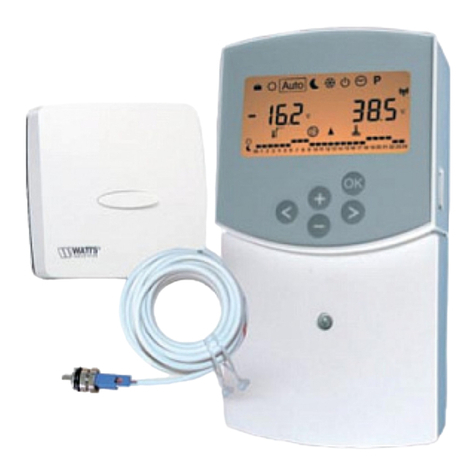
Watts
Watts Climatic Control CC-H User manual
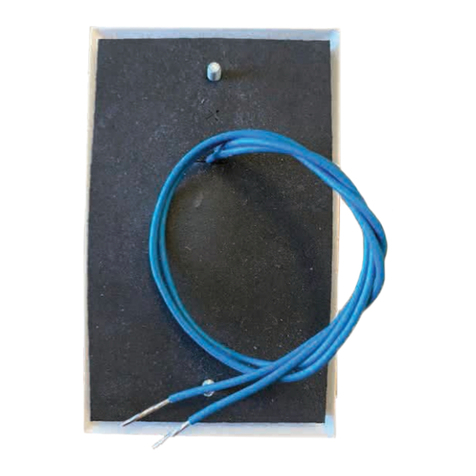
Watts
Watts Tekmar 077 User manual
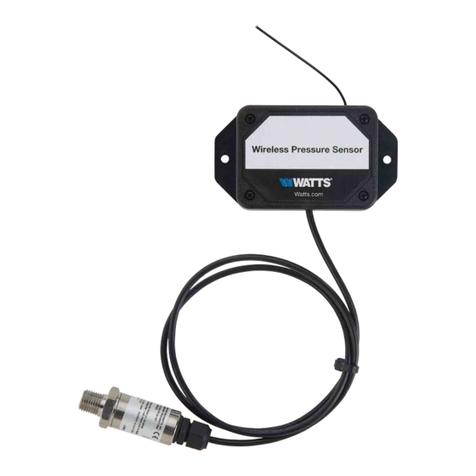
Watts
Watts Wireless Pressure Sensor User manual
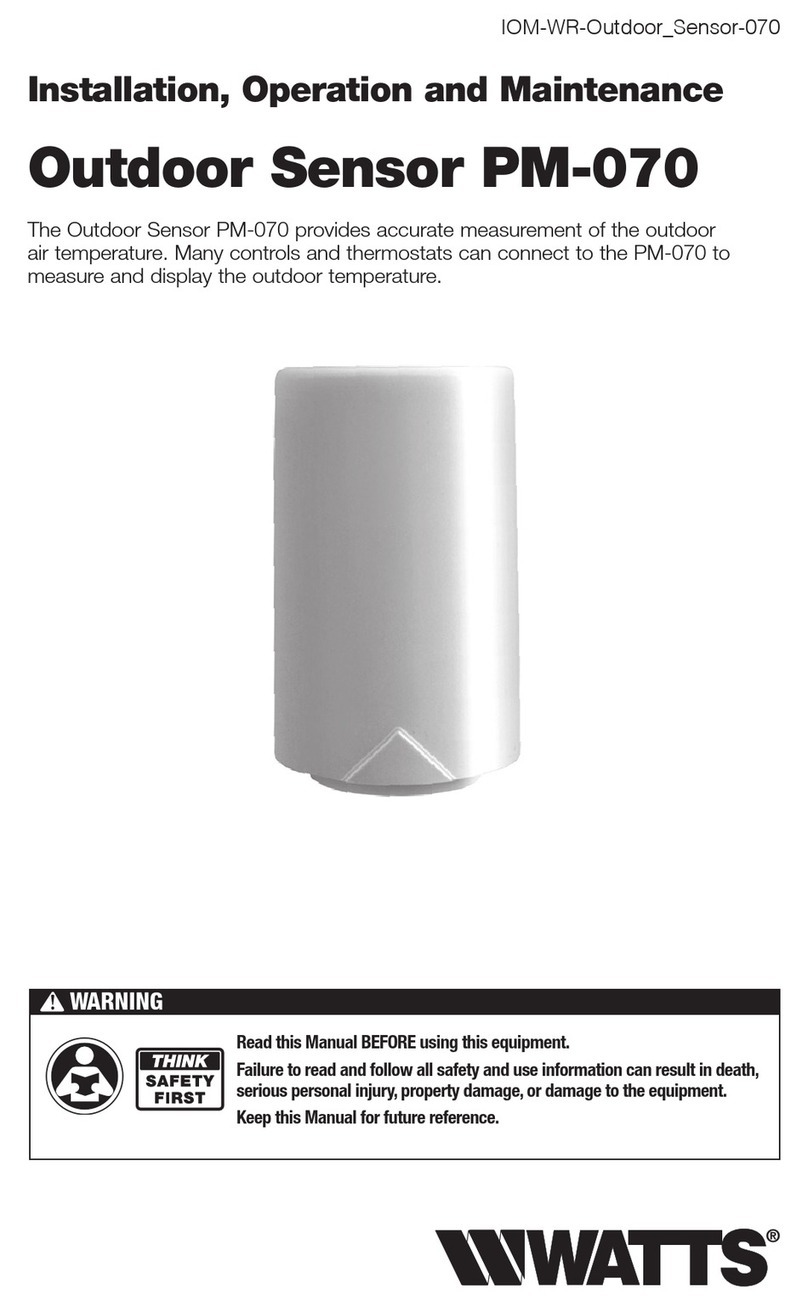
Watts
Watts PM-070 Manual
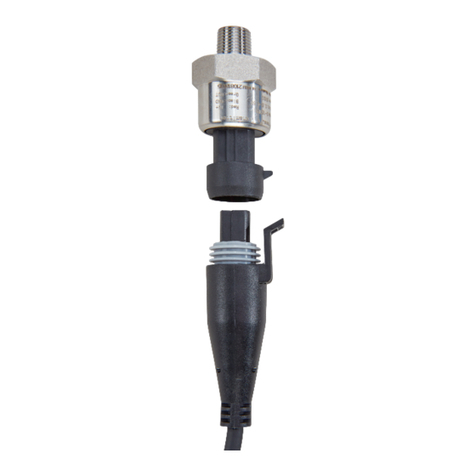
Watts
Watts tekmar 088 User manual
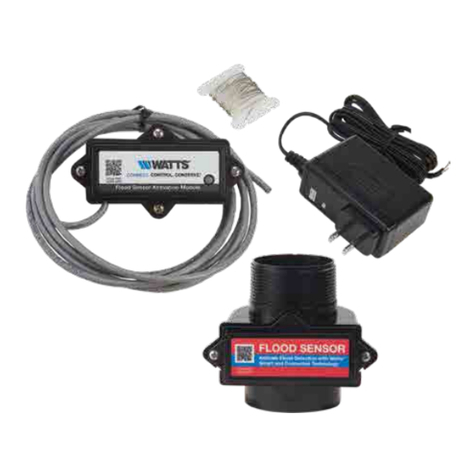
Watts
Watts BMS User manual
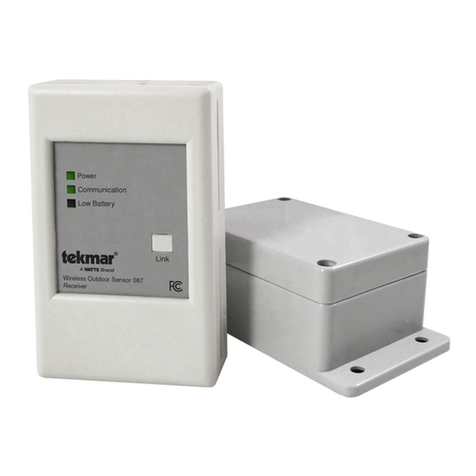
Watts
Watts tekmar 087 User manual
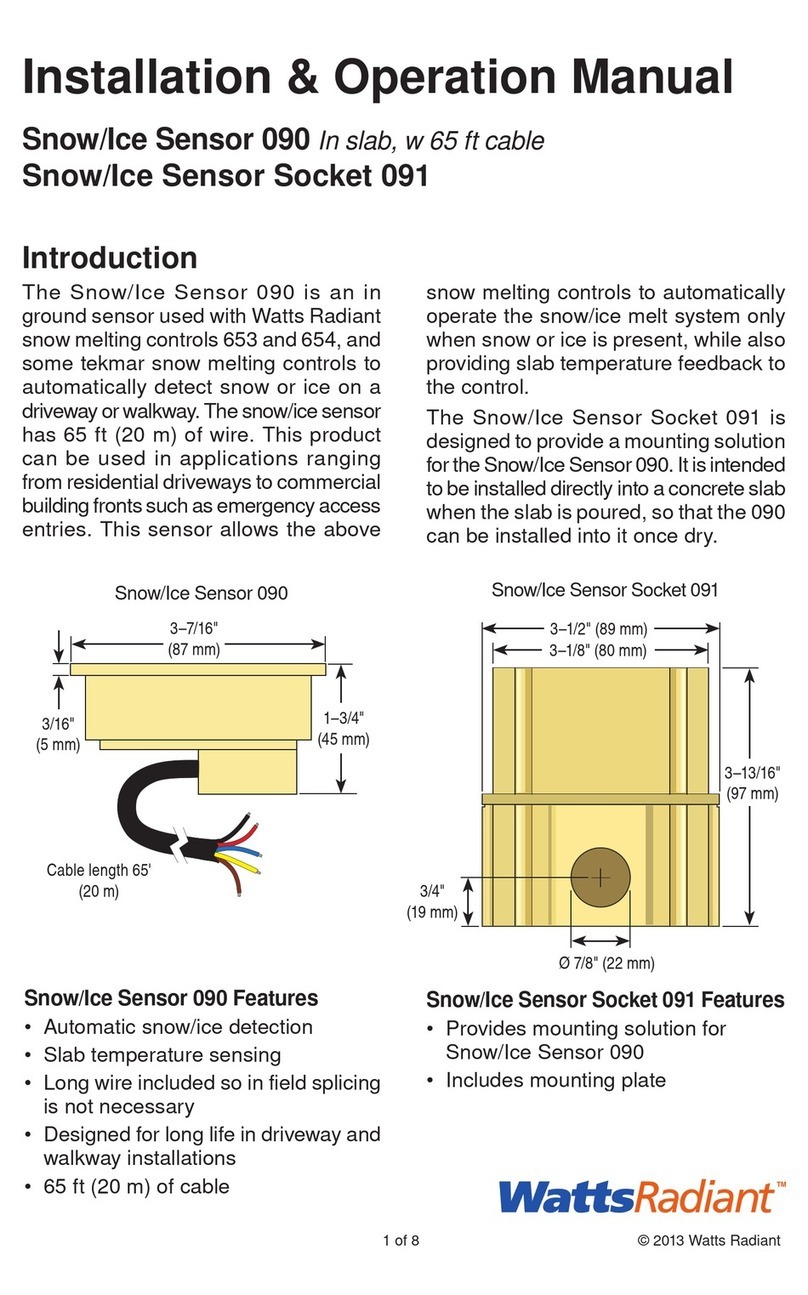
Watts
Watts Snow/Ice Sensor Socket 091 User manual

















